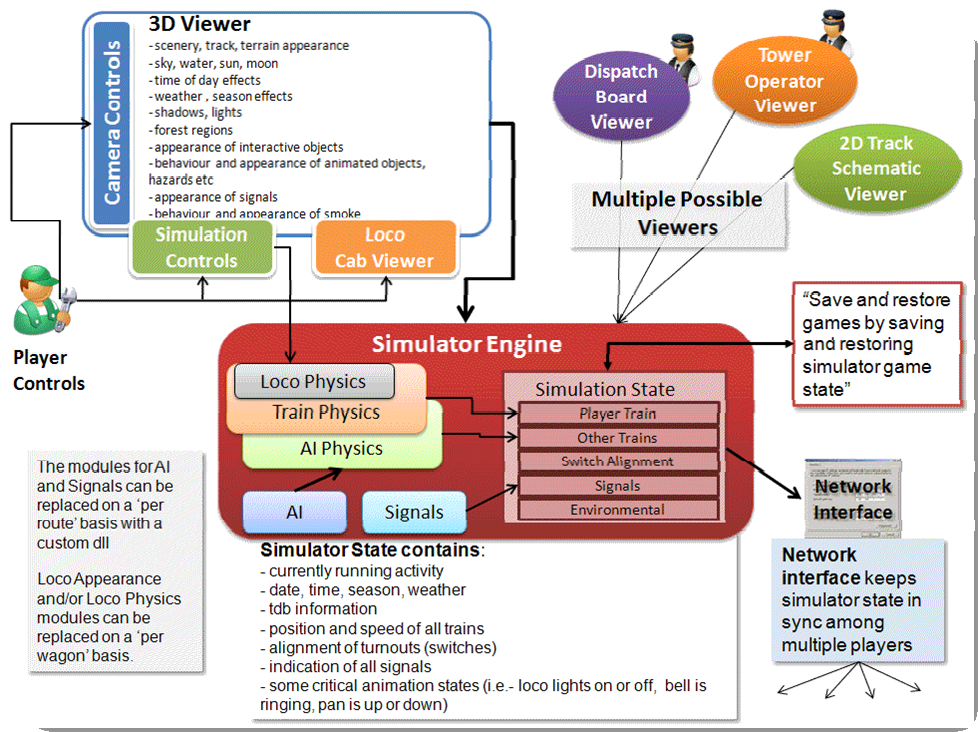19. Open Rails Software Platform¶
19.1. Architecture¶
To better understand how the Open Rails game operates, performs, and functions, the architecture diagram below lays out how the software code is organized. The architecture of the Open Rails software allows for modular extension and development, while providing standardized methods to customize the simulation experience.
Note
Please note that this diagram includes many capabilities and functions that are yet to be implemented.

19.2. Open Rails Game Engine¶
The Open Rails software is built on Microsoft’s XNA game platform using XNA Framework 3.1 and .NET Framework 3.5 SP1. Source code is developed in Microsoft’s Visual C# programming language.
The XNA Framework is based on the native implementation of .NET Compact Framework for Xbox 360 development and .NET Framework on Windows. It includes an extensive set of class libraries, specific to game development, to promote maximum code reuse across target platforms. The framework runs on a version of the Common Language Runtime that is optimized for gaming to provide a managed execution environment. The runtime is available for Windows XP, Windows Vista, Windows 7, Windows 8, and Xbox 360. Since XNA games are written for the runtime, they can run on any platform that supports the XNA Framework with minimal or no modification of the Game engine.
Warning
A license fee is payable to Microsoft to use XNA Game Studio for Xbox 360 games. At this time, the Open Rails team has not investigated whether the Open Rails software is suitable for Xbox.
19.3. Frames per Second (FPS) Performance¶
FPS rate is as default not linked to the sync rate of the monitor. However, with this option FPS rate may be set at the value of the monitor refresh rate.
19.4. Game Clock and Internal Clock¶
Like other simulation software, Open Rails software uses two internal clocks; a game clock and an internal clock. The game clock is required to synchronize the movement of trains, signal status, and present the correct game environment. The internal clock is used synchronize the software process for optimal efficiency and correct display of the game environment.
The Open Rails team is dedicated to ensuring the game clock properly manages time in the simulation, so that a train will cover the proper distance in the correct time. The development team considers this vital aspect for an accurate simulation by ensuring activities run consistently across community members’ computer systems.
19.5. Resource Utilization¶
Because Open Rails software is designed for Microsoft’s XNA game framework, it natively exploits today’s graphics cards’ ability to offload much of the display rendering workload from the computer’s CPU.
19.6. Multi-Threaded Coding¶
The Open Rails software is designed from the ground up to support up to 4 CPUs, either as virtual or physical units. Instead of a single thread looping and updating all the elements of the simulation, the software uses four threads for the main functions of the software.
- Thread 1 – Main Render Loop (RenderProcess)
- Thread 2 – Physics and Animation (UpdaterProcess)
- Thread 3 – Shape and Texture Loading/Unloading (LoaderProcess)
- Thread 4 – Sound
There are other threads used by the multiplayer code as each opened communication is handled by a thread.
The RenderProcess runs in the main game thread. During its initialization, it starts two subsidiary threads, one of which runs the UpdaterProcess and the other the LoaderProcess. It is important that the UpdaterProcess stays a frame ahead of RenderProcess, preparing any updates to camera, sky, terrain, trains, etc. required before the scene can be properly rendered. If there are not sufficient compute resources for the UpdaterProcess to prepare the next frame for the RenderProcess, the software reduces the frame rate until it can catch up.
Initial testing indicates that stutters are significantly reduced because the process (LoaderProcess) associated with loading shapes and textures when crossing tile boundaries do not compete with the main rendering loop (RenderProcess) for the same CPU cycles. Thread safety issues are handled primarily through data partitioning rather than locks or semaphores to maximise performance.
Ongoing testing by the Open Rails team and the community will determine what and where the practical limits of the software lie. As the development team receives feedback from the community, improvements and better optimization of the software will contribute to better overall performance – potentially allowing high polygon models with densely populated routes at acceptable frame rates.